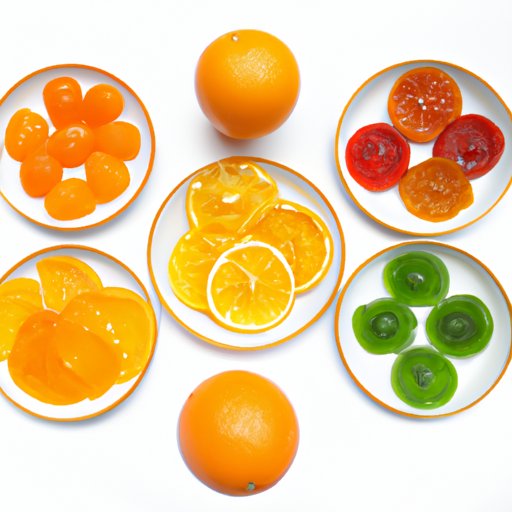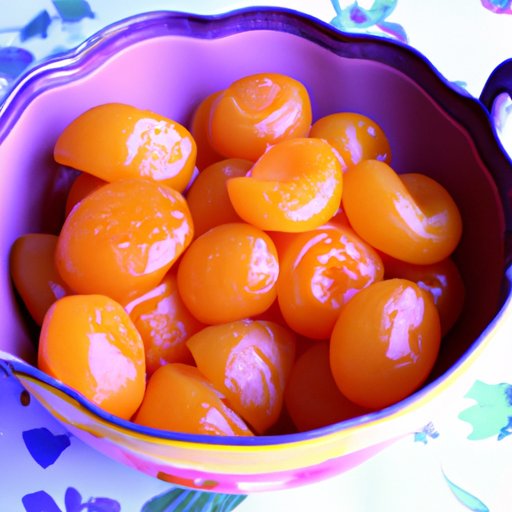Introduction
If you ask someone what marmalade is, chances are that they won’t be able to give you a clear answer. This classic spread has been around for centuries and yet it remains a mystery to many people. In this article, we aim to provide you with a comprehensive guide to marmalade, including its history, health benefits, and ways to use it in cooking and baking.
History of Marmalade: A Dive into the Origins of a Classic Spread
Marmalade originated in Portugal in the 16th century, and the first recipes were made using quinces. However, it wasn’t until the 18th century and the arrival of citrus fruit in Europe that marmalade as we know it today became popular. The word “marmalade” comes from the Portuguese word “marmelos,” which means quinces.
Over time, recipes for marmalade have changed, and today there are many different methods and variations. In earlier times, the process of making marmalade used to take several days, with the fruit and sugar being slowly boiled together. Nowadays, recipe variations use different fruit combinations and cooking methods, but the basic principles of making marmalade remain the same.
Marmalade has played an important role in different cultures around the world. In the United Kingdom, it is an essential part of breakfast, served with toast and tea. In Scotland, there is a special version made with whisky. In Spain, marmalade is used in pastries and cakes, and in Portugal it is a popular topping for bread and cheese.
How to Make Marmalade from Scratch: A Simple Recipe for Beginners
Do you want to try making your own marmalade? Here is a simple recipe that you can use:
Ingredients:
- 3 large oranges
- 1 lemon
- 4 cups of water
- 5 cups of sugar
Equipment:
- Large pot
- Wooden spoon
- Measuring cups and spoons
- Jar with lid
Directions:
- Wash the oranges and lemon thoroughly. Remove the skin from the fruit and cut it into thin strips. Set aside.
- Cut the fruit in half and juice them. Remove any seeds and pith. Set aside.
- Add the fruit peel to a large pot with water and bring to a boil. Reduce the heat and let the mixture simmer for an hour.
- Add the fruit juice and sugar to the pot, stirring until the sugar dissolves. Increase the heat and bring the mixture to a rapid boil.
- Boil for 15-20 minutes, stirring occasionally, until the mixture has thickened and reaches a temperature of 221°F (105°C).
- Remove from heat and let the mixture cool for a few minutes. Pour into a sterilized jar and seal.
This recipe makes about 4 cups of marmalade. Store your homemade marmalade in a cool, dry place, and it will last for up to six months.
The Health Benefits of Marmalade: Why Citrus Fruit and Sugar Make a Winning Combination
Marmalade is made from citrus fruit, and citrus fruits are known to be rich in vitamin C and other antioxidants. Vitamin C plays a crucial role in supporting a healthy immune system, and it can also help prevent cell damage caused by free radicals. The pectin in citrus fruit can also help lower cholesterol and improve digestion.
However, it’s important to remember that marmalade is still high in sugar, so it should be consumed in moderation. But the combination of citrus fruit and sugar can be a healthier alternative to other spreads, as it provides some essential vitamins and minerals that other spreads lack.
The Best Ways to Use Marmalade in Your Cooking and Baking: Tips and Tricks for a Flavorful Addition
Marmalade is a versatile ingredient that can be used in a variety of dishes, both sweet and savory. Here are some ideas:
Breakfast:
- On toast or bagels
- Mixed into yogurt or oatmeal
- As a glaze for bacon or ham
Desserts:
- As a filling for cakes or cupcakes
- Mixed into cookie or crumble toppings
- As a topping for ice cream or cheesecake
Savory dishes:
- As a marinade or glaze for chicken or salmon
- Mixed into salad dressings or as a topping for salads
- As a condiment for cheese plates or charcuterie boards
When pairing marmalade with other ingredients, consider the flavor and texture profile. Marmalade pairs well with creamy and salty flavors, as well as with spices like ginger and cinnamon.
Marmalade Taste Test: Comparing Quality and Flavor of Store-Bought Brands
If you’re not up to making your own marmalade or just want to try different varieties, you can opt for store-bought brands. However, with so many options to choose from, it can be tough to make a decision.
We conducted a blind taste test of different store-bought marmalades, evaluating them based on flavor, texture, and overall quality. The results were surprising, and we found that some of the lesser-known brands outshined the more popular ones.
When selecting a store-bought marmalade, consider the ingredients list and the sugar content. Look for brands that use natural ingredients and have lower sugar content.

The World of Citrus: Exploring the Different Types of Fruit Used in Marmalade Production
Marmalade can be made from almost any citrus fruit, but some fruits are more popular than others. The most common citrus fruit used in marmalade production are:
- Oranges: Valencia and Seville oranges are the most popular choices for marmalade. Seville oranges are tart and bitter, making them ideal for marmalade with a bold flavor.
- Lemons: Lemons can be used alone or combined with other citrus fruits to make marmalade. They provide a bright, tangy flavor.
- Limes: Limes are less common in marmalade production, but they can add a unique twist to traditional recipes.
- Grapefruits: Ruby Red grapefruits can be used to make a delicious and flavorful marmalade.
Each type of citrus fruit has its own distinct flavor and texture, which makes it possible to create a wide variety of marmalades. Experiment with different citrus fruits to find your favorite combination.
Marmalade Around the World: Traditional Recipes and Variations from Different Cultures
Marmalade may have originated in Portugal, but it has traveled around the world and taken on different forms. Here are some unique variations:
- Scottish whisky marmalade: Made with Seville oranges, sugar, and whisky, this variation has a unique smoky flavor.
- Spanish membrillo: A quince version of marmalade that’s used to make pastries and cakes.
- Italian bergamot marmalade: Made with bergamot oranges, this marmalade has a rich, complex flavor.
- Mexican lime marmalade: This marmalade is made with lime juice and zest and has a tangy and tart flavor.
Each variation has its own unique ingredients, preparation methods, and flavor profiles. Try making your own variations at home and explore the world of marmalade.
Conclusion
Marmalade may seem like a mystery to many, but it’s a classic spread that has been around for centuries. We’ve provided a comprehensive guide to marmalade, including its history, health benefits, and ways to use it in cooking and baking. Whether you make your own marmalade or opt for store-bought brands, we encourage you to explore the wide variety of marmalades and incorporate this delicious and healthy spread into your daily routine.
